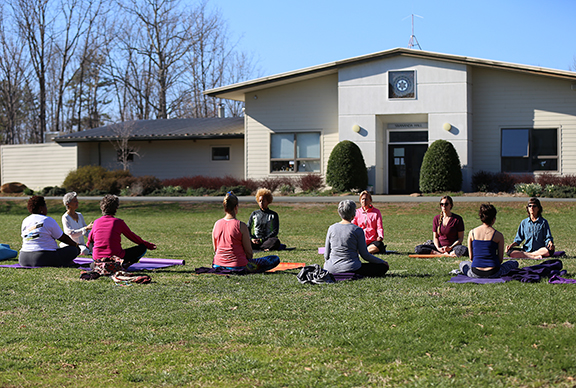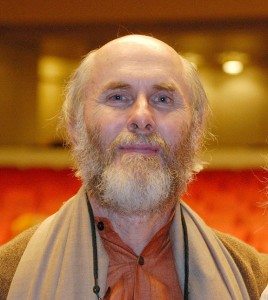 Many westerners are first introduced to Yoga through asana, the practice of the yogic postures. As one’s practice deepens, it can lead to an interest in further exploring aspects of Yoga. In this interview, we talk with Dr. David Frawley—considered to be an acharya, a scholar and authority on yogic, Vedic and Ayurvedic sciences—about what it means to develop a Yoga sadhana, a formal practice of classical Yoga.
Many westerners are first introduced to Yoga through asana, the practice of the yogic postures. As one’s practice deepens, it can lead to an interest in further exploring aspects of Yoga. In this interview, we talk with Dr. David Frawley—considered to be an acharya, a scholar and authority on yogic, Vedic and Ayurvedic sciences—about what it means to develop a Yoga sadhana, a formal practice of classical Yoga.
Integral Yoga Magazine (IYM): What is “sadhana” according to classical Yoga texts?
David Frawley (DF): Traditionally, Yoga is a sadhana, and a sadhana implies a daily practice, lifestyle, routine and regimen. If you want to employ Yoga at a deeper spiritual level, then you employ Yoga as a sadhana and you are called a sadhak, one who is engaged in sadhana. The term sadhana is from the root “sadh,” from which we get the word, siddhi, which means to accomplish, perfect, realize, manifest or to make real. Sadhana is a way of completing or perfecting a work. So many people define Yoga as a workout, wellness system or therapy and we need to introduce it as a sadhana in which we work to raise our consciousness
Traditionally, Yoga is defined as a sadhana in the sense of Atma siddhi: Self-realization or God-realization, union with Ishvara. It entails a whole procedure. The second section of the Yoga Sutras is called Sadhana Pada. It follows the first section, Samadhi Pada. Sadhana Pada introduces Kriya Yoga, Ashtanga Yoga and a whole range of Yoga practices in order to realize the goal of Yoga. So, Yoga, in the traditional sense, is primarily a sadhana.
IYM: Why does Samadhi Pada come first in the Yoga Sutras?
DF: Samadhi Pada comes first for those who can directly enter into samadhi, which is very few. Then comes the sadhana practice to prepare us to enter into higher states of consciousness. Sadhana is also a means of preparing oneself, perfecting oneself and making oneself better.
IYM: Patanjali begins Sadhana Pada with Kriya Yoga. What is the relationship between sadhana and the three components of Kriya Yoga?
DF: Kriya Yoga is the Yoga of action, but this refers to an internal rather than an external action. The internal action of Yoga is a sadhana that is comprised of tapas, svadhyaya and Ishvara pranidhana. Tapas comes first because it’s what ripens or prepares us. Tapas means heat, gestating, preparing and ripening. All the Yoga practices are types of tapas because they involve the application of heat, pressure, energy, motivation and aspiration to bring about a change in our being and our consciousness. Sometimes tapas is wrongly translated as austerity or asceticism. However, tapas refers more to the application of energy or aspiration, like the inspiration that underlies an artist’s work. Without tapas, your sadhana can degenerate into a kind of routine or mechanical thing you do because you want to get something. Tapas is that inner fire, the inner agni, that tejas that really drives one’s sadhana.
Ishvara pranidhana—the alignment of oneself with the divine presence within—has been already mentioned in the first part of the Yoga Sutras as a direct means of samadhi that doesn’t necessarily require an action or purification. It can exist in itself. But it can also be seen as an aspect of sadhana, because sadhana is not something done by our ego as the motivating force. It’s not a type of attempt to take control or take power over from the standpoint of the ego. It’s the alignment of our inner motivation with the Divine, or Ishvara. Ishvara pranidhana is an aspect of tapas. If Ishvara pranidhana is not there, then tapas becomes merely self-discipline for any egoistic pursuit.
Svadhaya refers to knowledge of one’s Self, studying the teachings that are related to one’s own constitution by way of the doshas, gunas and karmas. It implies an adaptation of the teachings at an individual level. As a knowledge component it also reflects vairagya and viveka, the factors of detachment and discrimination. Tapas is always done as a factor of svadhaya because it has to be adapted at an individual level, otherwise it can be just a form of effort or discipline that one has taken up externally. These three components taken all together help us understand the action of Yoga and Yoga sadhana. They are also the kernel that is later expanded into the eight limbs of Yoga, including the five yamas and five niyamas in which the factors of Kriya Yoga occur. Tapas is reflected in all the eight limbs and the other two components of Kriya Yoga.
IYM: How is sadhana viewed through the lens of Ayurveda?
DF: In Ayurvedic medicine, there are five forms of pitta dosha, or the biological fire humor that governs positive health functions. The most important one is the sadhak pitta, which is a force that governs over perception, judgment, reason and discrimination (viveka). It governs the nerve, brain and heart processes. This shows how sadhana is connected with a set of teachings and ideas that extend into how our physiology works. Sadhana is a way of improving the functioning of the mind, the heart, the deeper perceptive, cognitive, feeling nature and our deeper level of volition, aspiration and sankalpa (one’s will or willpower). So sadhana also rests on a personal motivation, or willpower, in which Yoga becomes one’s primary motivation in life, rather than something one does in one’s spare time or as an adjunct to one’s vocation. Yoga sadhana is your primary activity, which brings about an inner change in the consciousness, or chitta, and its alignment with the Purusha, or higher Self.
IYM: How do we determine what sadhana is best for us?
DF: To begin, you can study and learn about the Yoga system and various sadhanas. You can explore various classes, teachings and teachers and see what sadhanas resonate with you. As that emerges, you can go out and find those teachers who teach that particular sadhana. There’s a tendency for people to think they are exploring different types of Yoga sadhana by exploring different styles of asana. But, they should also explore the other limbs of Yoga: pranayama, mantra, pratyahara, dharana and so on. And they should explore the other branches of Yoga like: Jnana Yoga, the Yoga of knowledge; Bhakti Yoga, the Yoga of devotion, Karma Yoga, the Yoga of action and Kriya Yoga and so on. In the end, it’s always best to have an integral approach to Yoga and an integral sadhana, which is why Swami Satchidananda gave various practices for every aspect of your being: meditation for the mind, asana for the body, devotion for the heart and all the rest of it.
As we find in the Yoga Sutras, Yoga practice requires following the yamas and niyamas, dharmic principles and values in our daily lives. Yoga is not something that is done by the ego, not done to make money or to become famous but to help us reach a higher consciousness. Yoga is a body of knowledge, not just a system of practices. So in addition to asana, pranayama, meditation and other yogic practices, one’s sadhana should include the study of classical texts so you can understand how Yoga is linked to a philosophy. The problem today is that people practice Yoga without studying the philosophy behind Yoga. Their Yoga often becomes confused with doing something, when it’s really a part of a tradition of self-knowledge, introspection, a way of understanding the tattvas (cosmic principles) in order to connect to the Atma, the Purusha or the higher Self.
IYM: How do we integrate a complete Yoga sadhana into our daily lives?
DF: Yoga sadhana is comprised of a daily set of practices that permeate one’s entire life and which cover everything: starting with the yamas and niyamas, how we live, what we eat, what we do, what our values are, how we see things and then leading into more specialized Yoga practices such as asana, pranayama, mantra, meditation, rituals and so on. Sadhana implies a daily activity, a routine, but it can’t be mechanical. Sadhana is something that we bring into everything we do. Our work can be Karma Yoga as a sadhana. Even the food we eat can become a ritual, or yagya, or a sacrifice. We can bring sadhana into daily life by doing some mantras throughout the day. And, you should also set special times for a more formal sadhana: morning, evening where you do more specific practices.
The great yogis prescribed sadhanas. Swami Satchidananda had a community so he created a sadhana that would work for that community and as well for those who didn’t live in an ashram, or Yoga center. The practice of Yoga rests upon sadhana. Life is always a sadhana. Every day we are doing some things on a regular basis. And, when we do something regularly, it works its way into our psyche or gives us various skills. Whatever we most frequently do has a special impact on our psyche and subconscious mind.
The action of Yoga is an action in inaction. It is a way of undoing, a way of being and a way of reducing unnecessary action to take us to a point of stillness. Asana reduces physical activity, pranayama reduces the activity of the prana, pratyahara reduces the activity of the senses and meditation brings the mind to a place of silence. Patanjali defines Yoga as nirodha, which is the cessation of activity, particularly the disturbances, the vrittis, the activities of the chitta or mind. Yoga requires a sadhana so it’s very important that one look to the Yoga teachings, or teachers, and take up a sadhana and follow it regularly.

Dr. Frawley is one of the most honored acharyas of Vedic wisdom in India and in the western world over the last thirty years. He is respected as an Ayurvedacharya (teacher of Ayurvedic medicine), Jyotish Brihaspati (teacher of Vedic astrology), Vedacharya and Vedaguru (teacher of the Vedas). He is regarded as a Pandit, a doctor, or professor of Vedic wisdom. He is one of the few modern teachers to write definitive books in all major Vedic fields, based upon his original study of Sanskrit texts and his own direct experience, including commentaries on the Vedas themselves. For more information, please visit: www.vedanet.com.
From Integral Yoga Magazine, Fall 2011

